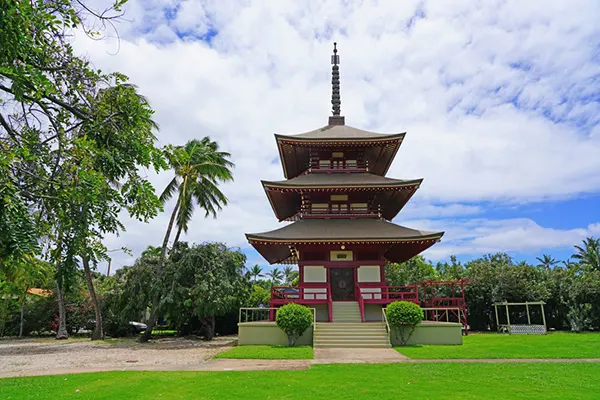The cultural history of Maui can be overlooked by visitors to the island, who get understandably distracted by the natural splendor of the beaches and parks.
But settlers have been on Maui since as early as 450 AD, leaving a rich heritage behind.
Much of Maui’s past has been destroyed, which is why it’s so important to appreciate what’s left. One of the most notable features of pre-contact Hawaii are the temples, also known as a heiau.
A visit to a heiau is a fascinating way to incorporate a cultural experience into your vacation.

What Is A Heiau?
Table of Contents
A “heiau” is a temple of the Hawaiian religion. The heiau had a vast range of uses, from treating the sick, asking for rain, and even human sacrifice (the heiau used for human sacrifice are known as luakini).
The structure of a heiau is variable, and changes depending on the use of the temple.
Some were simple terraces constructed of earth. Others were vast and elaborate stone platforms. A heiau would often be adapted over time as they acquired new uses.
How Many Heiau Are On Maui?
However, many of the heiau were destroyed when the traditional Hawaiian religion began being abolished in 1819. And then, when Christian missionaries arrived in 1820, the heiau were often torn down to make way for farms—or they were left abandoned.
There are three major areas with heiau left on Maui, and they’re fascinating places to visit.
So much of pre-contact Hawaii has been lost, and a trip to a temple is a way to discover a time and place still largely underappreciated.
1. Pi’ilanihale
Pi’ilanihale, otherwise known as Hale O Pi’ Ilani Heiau, is the largest heiau on Maui. It’s thought that work on the heiau first began in the 13th century, and that the temple was constructed in several stages.
At 415 feet long, and 340 feet wide, the site covers almost 3 acres of land. This heiau was once used as a residence: Pi’ilanihale translates to “the house of Pi’ilani”.
Built using basalt rocks that were carried by hand from local areas, the walls and structure of the heiau have been painstakingly restored using traditional techniques.
The multi-stepped terraces of the outward facing walls are unusual in design, making this a unique site on Maui. Pi’ilanihale is accessible to visitors of Kahana Garden.
2. Haleki’i-Pihana Heiau State Monument
Haleki’i-Pihana Heiau State Monument park is notable for containing two heiau. This 10 acre park situated near the mouth of the ‘Iao stream in Wailuku is an often overlooked spot, but visitors hoping to discover more about Maui history should definitely stop by.
The first of the two temples is known as Pihana, or Pihanakalani. Thought to have been built between 1260 and 1400, this heiau was known as “the gathering,” and “the gathering of the supernatural.” In the centuries since, the heiau was expanded, and used as a residence.
The second heiau, Haleki’i was added around the time of the Pihana expansion.
Both heiau are thought to have been luakini heiau: a place to pray for success in war, and to offer blood sacrifice.
There’s little other than the lava rock base remaining of each heiau, having been destroyed in recent decades.
The Haleki’i-Pihana Heiau State Monument is free to visit, and the panoramic views of Wailuku serve as a stunning backdrop to a fascinating piece of history.
3. Loaloa
Kaupo is a rural area of Maui, often underappreciated by visitors to the island. However, Kaupo was once a cultural center on Maui, and a place of religious importance. Many heiau were constructed within the Kaupo area, with the best preserved temple being Loaloa.
Stories passed down by Hawaiian locals talk of Loaloa being constructed in 1730. The large structure was built as a luakini heiau for Kekaulike, the ruler of the island at the time. The three-tiered stone platform is large, and surprisingly intact.
Another heiau found in Kaupo is Popoiwi, or Keakalauae.
Other Interesting Temple Sites:
Lahaina Jodo Mission
The Lahaina Jodo Mission is a tranquil temple, established in Lahaina in 1912.
In 1968, a large bronze Buddha was added to the grounds, to commemorate the 100-year anniversary of Japanese immigrants arriving in Hawaii.
Known for its peaceful grounds, the Lahaina Jodo Mission is a calming place to walk and rejuvenate.
Ka’ahumanu Church
Ka’ahumanu Church was built in 1876, in honor of Queen Ka’ahumanu, an early Hawaiian adopter of Christianity.
The impressive white building is in Wailuku, where it’s still in use today.
Services are conducted in a mixture of English, and the traditional Hawaiian language.
